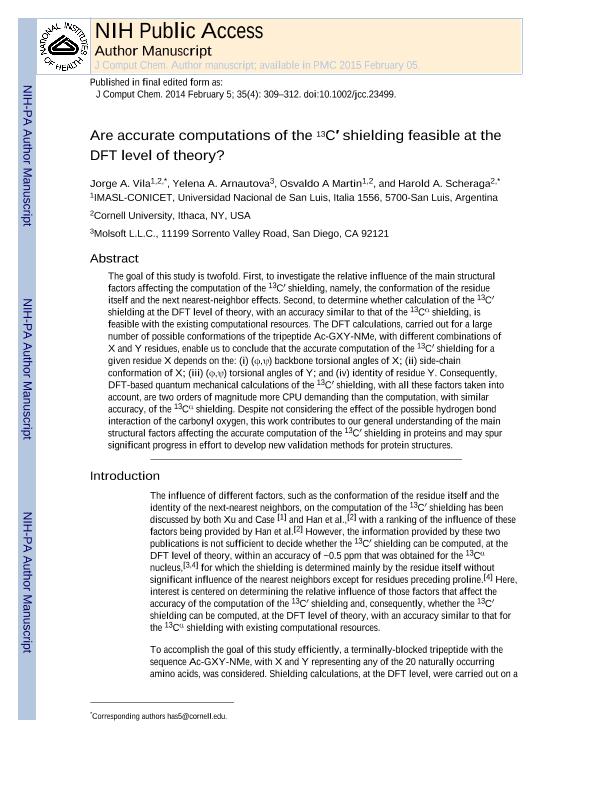Mostrar el registro sencillo del ítem
dc.contributor.author
Vila, Jorge Alberto

dc.contributor.author
Arnautova, Yelena A.

dc.contributor.author
Martín, Osvaldo Antonio

dc.contributor.author
Scheraga, Harold A.

dc.date.available
2017-12-21T20:39:44Z
dc.date.issued
2014-02
dc.identifier.citation
Vila, Jorge Alberto; Arnautova, Yelena A.; Martín, Osvaldo Antonio; Scheraga, Harold A.; Are accurate computations of the 13C' shielding feasible at the DFT level of theory?; Wiley; Journal Of Computational Chemistry; 35; 4; 2-2014; 309-312
dc.identifier.issn
0192-8651
dc.identifier.uri
http://hdl.handle.net/11336/31301
dc.description.abstract
The goal of this study is twofold. First, to investigate the relative influence of the main structural factors affecting the computation of the 13C0 shielding, namely, the conformation of the residue itself and the next nearest-neighbor effects. Second, to determine whether calculation of the 13C0 shielding at the density functional level of theory (DFT), with an accuracy similar to that of the 13Ca shielding, is feasible with the existing computational resources. The DFT calculations, carried out for a large number of possible conformations of the tripeptide Ac-GXY-NMe, with different combinations of X and Y residues, enable us to conclude that the accurate computation of the 13C0 shielding for a given residue X depends on the: (i) (/,w) backbone torsional angles of X; (ii) side-chain conformation of X; (iii) (/,w) torsional angles of Y; and (iv) identity of residue Y. Consequently, DFT-based quantum mechanical calculations of the 13C0 shielding, with all these factors taken into account, are two orders of magnitude more CPU demanding than the computation, with similar accuracy, of the 13Ca shielding. Despite not considering the effect of the possible hydrogen bond interaction of the carbonyl oxygen, this work contributes to our general understanding of the main structural factors affecting the accurate computation of the 13C0 shielding in proteins and may spur significant progress in effort to develop new validation methods for protein structures.
dc.format
application/pdf
dc.language.iso
eng
dc.publisher
Wiley

dc.rights
info:eu-repo/semantics/openAccess
dc.rights.uri
https://creativecommons.org/licenses/by-nc-sa/2.5/ar/
dc.subject
Dft-Computation of Shielding
dc.subject
Protein Validation
dc.subject
Protein Determination
dc.subject
Factors Affecting Shielding Computation
dc.subject
Heavy Nuclei Shielding
dc.subject.classification
Otras Ciencias Biológicas

dc.subject.classification
Ciencias Biológicas

dc.subject.classification
CIENCIAS NATURALES Y EXACTAS

dc.title
Are accurate computations of the 13C' shielding feasible at the DFT level of theory?
dc.type
info:eu-repo/semantics/article
dc.type
info:ar-repo/semantics/artículo
dc.type
info:eu-repo/semantics/publishedVersion
dc.date.updated
2017-12-12T18:38:32Z
dc.journal.volume
35
dc.journal.number
4
dc.journal.pagination
309-312
dc.journal.pais
Estados Unidos

dc.journal.ciudad
Hoboken
dc.description.fil
Fil: Vila, Jorge Alberto. Cornell University; Estados Unidos. Consejo Nacional de Investigaciones Científicas y Técnicas. Centro Científico Tecnológico Conicet - San Luis. Instituto de Matemática Aplicada de San Luis ; Argentina
dc.description.fil
Fil: Arnautova, Yelena A.. Molsoft L.L.C.; Estados Unidos
dc.description.fil
Fil: Martín, Osvaldo Antonio. Cornell University; Estados Unidos. Consejo Nacional de Investigaciones Científicas y Técnicas. Centro Científico Tecnológico Conicet - San Luis. Instituto de Matemática Aplicada de San Luis ; Argentina
dc.description.fil
Fil: Scheraga, Harold A.. Cornell University; Estados Unidos
dc.journal.title
Journal Of Computational Chemistry

dc.relation.alternativeid
info:eu-repo/semantics/altIdentifier/url/http://onlinelibrary.wiley.com/doi/10.1002/jcc.23499/abstract
dc.relation.alternativeid
info:eu-repo/semantics/altIdentifier/doi/http://dx.doi.org/10.1002/jcc.23499
Archivos asociados
